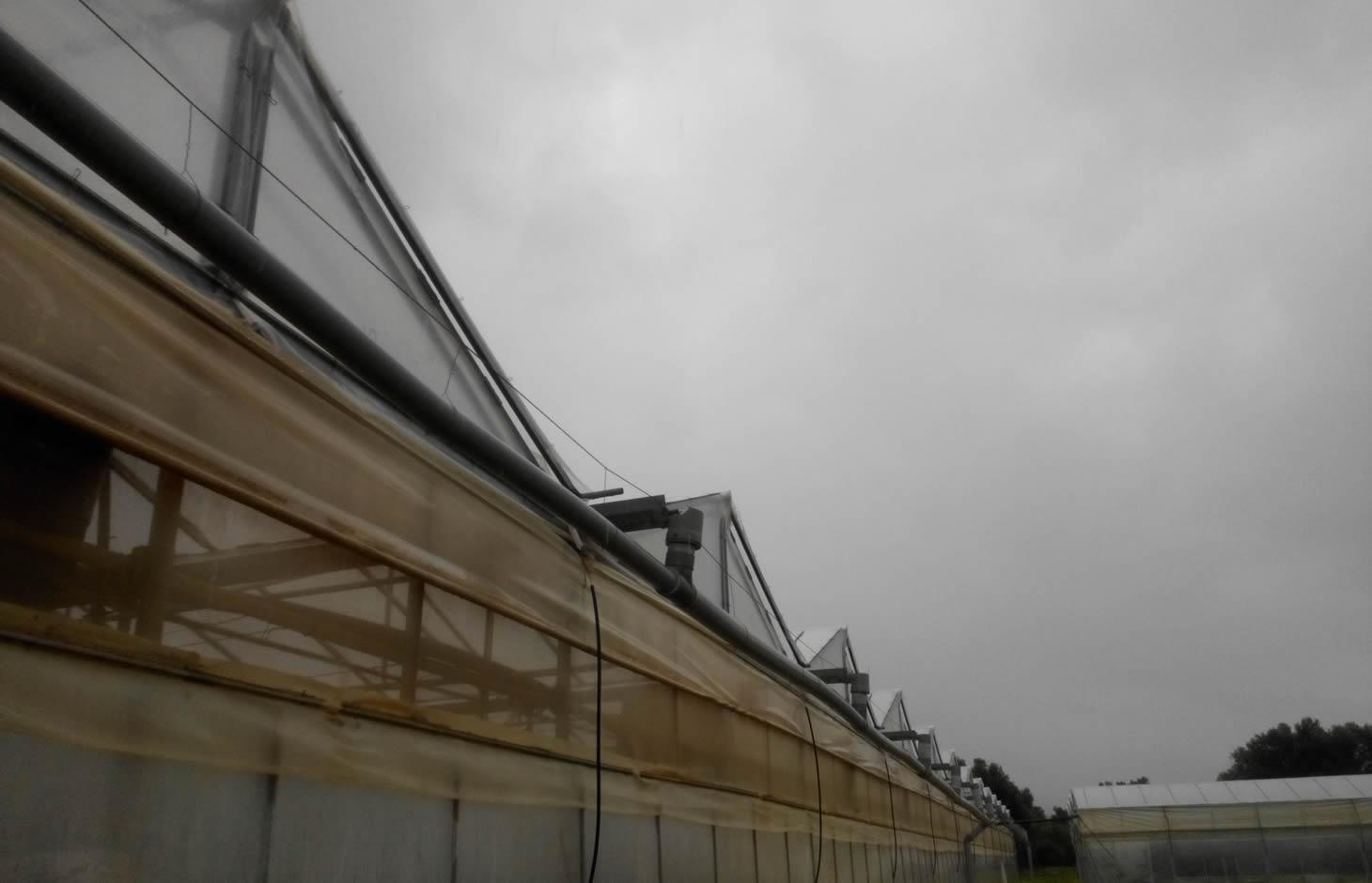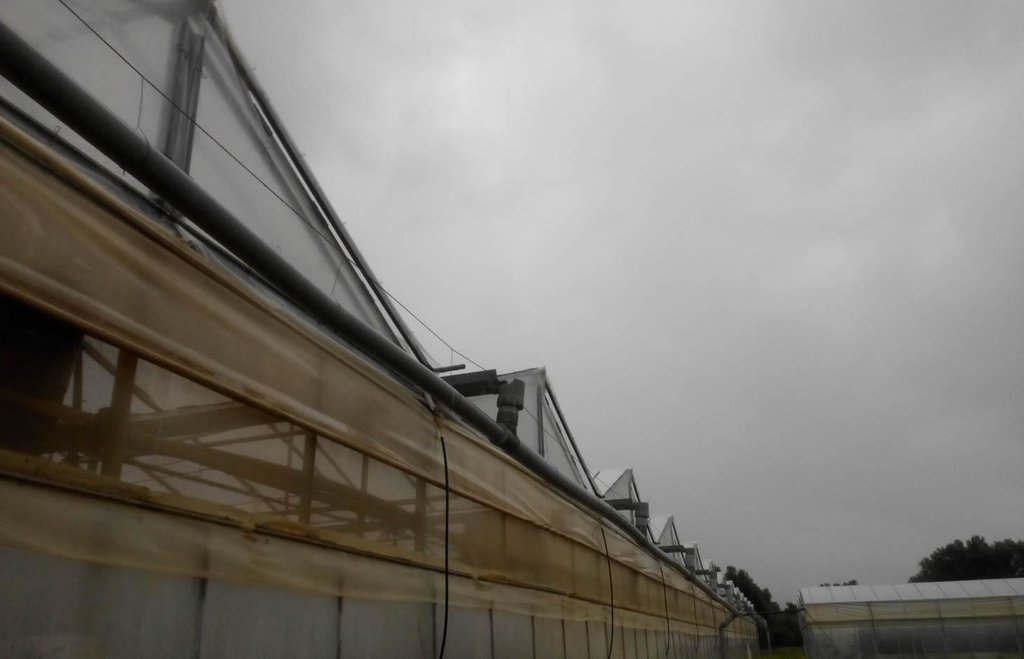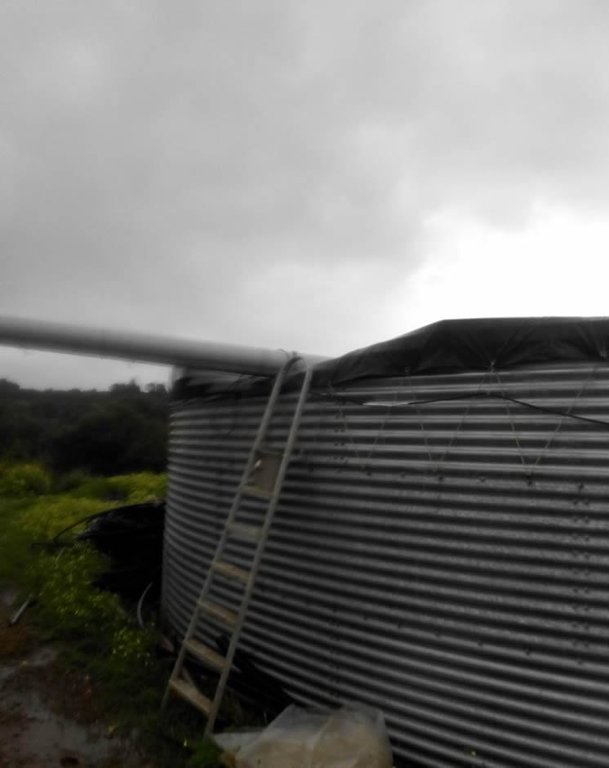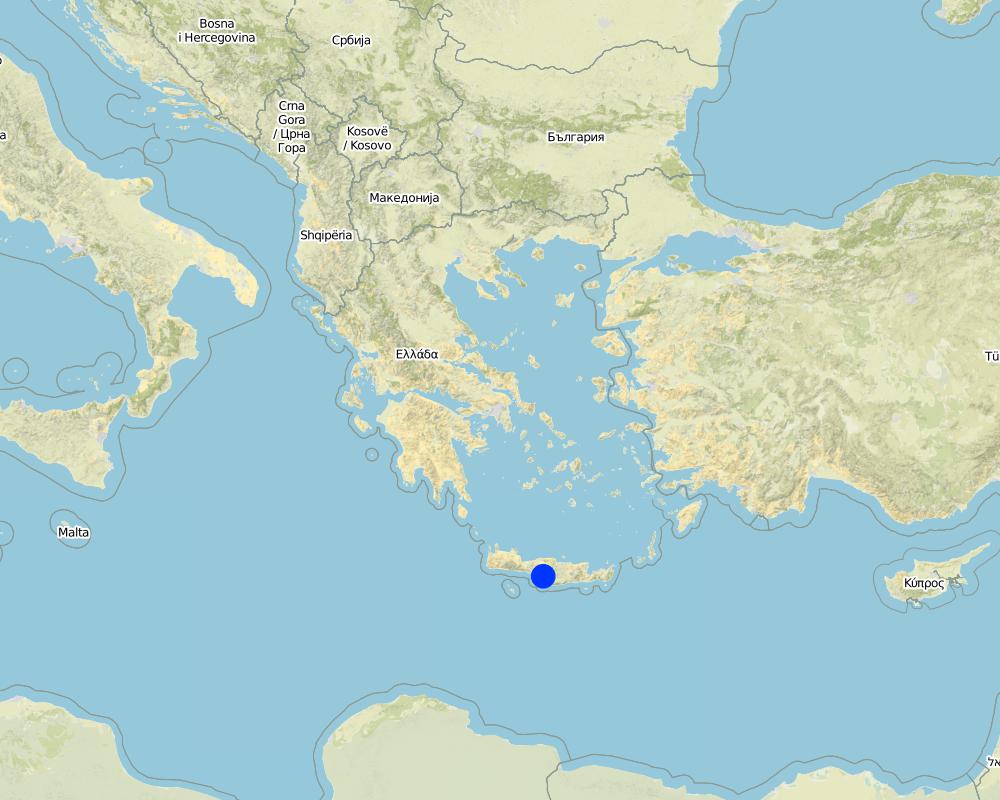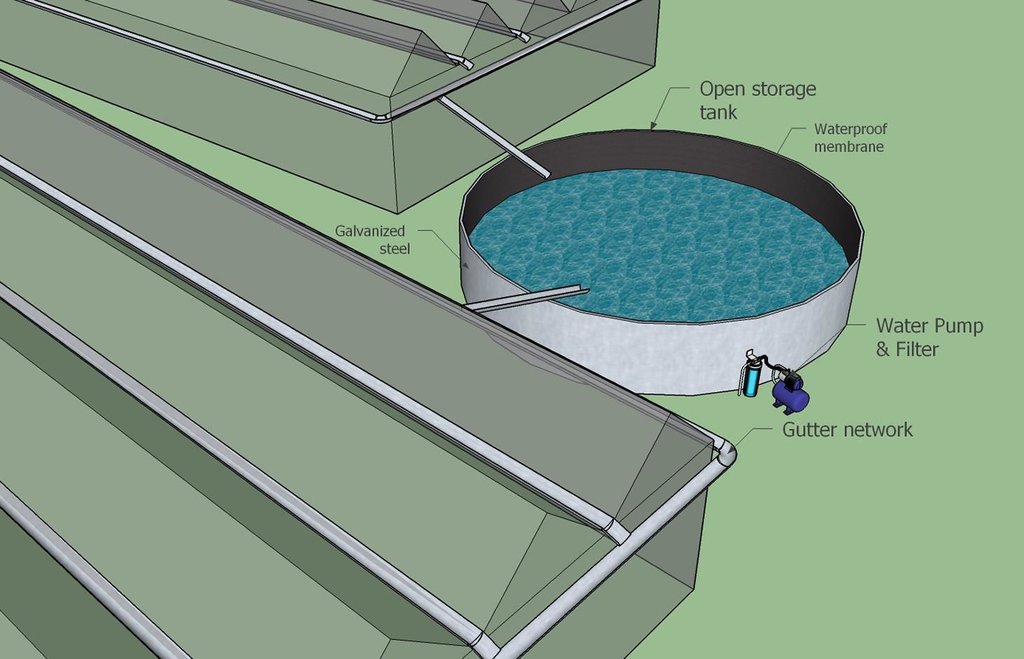Rainwater harvesting for greenhouse irrigation [Greece]
- Creation:
- Update:
- Compiler: Ioanna Panagea
- Editor: –
- Reviewers: Deborah Niggli, Alexandra Gavilano
Σύστημα συγκομιδής ομβρίων υδάτων από θερμοκήπια με σκοπό την άρδευση
technologies_1658 - Greece
View sections
Expand all Collapse all1. General information
1.2 Contact details of resource persons and institutions involved in the assessment and documentation of the Technology
SLM specialist:
Name of project which facilitated the documentation/ evaluation of the Technology (if relevant)
Preventing and Remediating degradation of soils in Europe through Land Care (EU-RECARE )Name of the institution(s) which facilitated the documentation/ evaluation of the Technology (if relevant)
Technical University of Crete (Technical University of Crete) - Greece1.3 Conditions regarding the use of data documented through WOCAT
The compiler and key resource person(s) accept the conditions regarding the use of data documented through WOCAT:
Yes
1.4 Declaration on sustainability of the described Technology
Is the Technology described here problematic with regard to land degradation, so that it cannot be declared a sustainable land management technology?
No
2. Description of the SLM Technology
2.1 Short description of the Technology
Definition of the Technology:
Rain water harvesting from greenhouses roofs.
2.2 Detailed description of the Technology
Description:
The roof of a greenhouse is used as catchment area for rainwater harvesting. A system of gutters is installed to channel water into a storage facility that can be either above ground or at ground level, open or covered. The water harvested from the roofs is used for irrigation purposes, either on its own or mixed with other sources.
In central and eastern Crete, a negative water balance emerges due to agricultural exploitation and lack of sustainable water resources management. Regarding water availability, it is notable that the spatial and temporal variability of precipitation are the limiting factors, rather than overall precipitation quantity. Especially in coastal areas where the main source of irrigation is groundwater, seawater intrusion often takes place, and eventually leading to irrigation with saline water. In the intensive agriculture and water stress conditions existing in greenhouses this situation can progressively lead to soil salinisation with subsequent adverse effects on production. The technology promotes sustainable land management through prevention and mitigation of land degradation by increasing water resources self-sufficiency thus allowing the user to rely less on the scarce groundwater resources and reduce the risk of production failure. Furthermore, the technology improves the overall irrigation water quality. The main disadvantage of the technology is the increase of agricultural inputs (fertilizers) because of the lack of minerals necessary for the crops (especially tomatoes) in the rainwater. This disadvantage can be mitigated by mixing rainwater with other sources.
The majority of the greenhouses in the region normally have built-in gutters between the basic construction units in order to discharge rainwater from the roof for structural safety. Thus, initially little structural measures are required including the implementation of some further gutters that channel rainwater in the storage system and preparation of the area for the tank installation. Overland tanks may consist of galvanized steel or similar material. Ground level storage usually requires earth removal. In both case, the installation of the relevant waterproofing material is required to avoid leaks. A cover may also be installed to reduce evaporation. Here we assess the use of a harvesting system comprising of (a) an above ground circular tank made out of galvanized steel with total volume of 320 m3 and (b) a gutter network spreading on the roof of a 0.7 ha greenhouse. Furthermore, a water filter and water treatment may be required for removal of particles and waterborne disease mitigation. Finally, a suitable pump and mixing facilities are installed to control water quality and quantity.
The average annual precipitation in the area is 500 mm and the climate ranges between sub-humid Mediterranean and semi-arid. Average annual temperature is 18.5 °C with 6 months below 18 °C but above 5 °C, thus classifying the area as subtropical. In the location where the technology is applied, land is mostly privately owned and water rights can be public, cooperative or private. Although the financial means of the land user who applies this technology are more or less on par with those of the rest of the community, he has a wider empirical education and relatively higher social status acquired thought his involvement with the commons and the water resources management of the region.
This Technology was documented within the scope of FP7 RECARE Project, funded grant agreement no 603498.
2.3 Photos of the Technology
2.5 Country/ region/ locations where the Technology has been applied and which are covered by this assessment
Country:
Greece
Region/ State/ Province:
Heraklion
Further specification of location:
Timpaki
Comments:
Total area covered by the SLM Technology is 0.007 km2.
Map
×2.6 Date of implementation
If precise year is not known, indicate approximate date:
- 10-50 years ago
2.7 Introduction of the Technology
Specify how the Technology was introduced:
- through projects/ external interventions
Comments (type of project, etc.):
The land user has implemented the water harvesting technology in order to be subsidized from an agri-environmental scheme under the CAP.
3. Classification of the SLM Technology
3.2 Current land use type(s) where the Technology is applied

Cropland
- Annual cropping
- tomatoes
Number of growing seasons per year:
- 1
Specify:
Longest growing period in days: 270, Longest growing period from month to month: October to June

Settlements, infrastructure
- Settlements, buildings
Comments:
Major land use problems (compiler’s opinion): The main problem in the region is the change in the groundwater quality, caused by groundwater over-exploitation and the subsequent seawater intrusion, resulting in soil salinisation through irrigation.
Major land use problems (land users’ perception): The limited availability of good quality (non-saline) water for irrigation resulting in increased production risk and agricultural inputs.
3.4 Water supply
Water supply for the land on which the Technology is applied:
- full irrigation
3.5 SLM group to which the Technology belongs
- water harvesting
- irrigation management (incl. water supply, drainage)
3.6 SLM measures comprising the Technology

structural measures
- S5: Dams, pans, ponds
- S11: Others
Comments:
Main measures: structural measures
Specification of other structural measures: Greenhouse roof gutter network
3.7 Main types of land degradation addressed by the Technology

chemical soil deterioration
- Cs: salinization/ alkalinization

biological degradation
- Bq: quantity/ biomass decline

water degradation
- Hg: change in groundwater/aquifer level
Comments:
Main type of degradation addressed: Cs: salinisation / alkalinisation, Hg: change in groundwater / aquifer level
Secondary types of degradation addressed: Bq: quantity / biomass decline
Main causes of degradation: over abstraction / excessive withdrawal of water (for irrigation, industry, etc.) (Overpumping.), other human induced causes (specify) (Irrigation with brackish water.), droughts (Lack of sustainable water resources.), inputs and infrastructure: (roads, markets, distribution of water points, other, …) (Poor coverage of freshwater irrigation network.)
Secondary causes of degradation: soil management (Intensive cultivation), disturbance of water cycle (infiltration / runoff) (Covering of land with green houses decreases leaching.)
3.8 Prevention, reduction, or restoration of land degradation
Specify the goal of the Technology with regard to land degradation:
- prevent land degradation
- reduce land degradation
4. Technical specifications, implementation activities, inputs, and costs
4.1 Technical drawing of the Technology
Technical specifications (related to technical drawing):
A network of gutters channels rainwater to an adequately insulated metal tank. The stored water is then used for irrigation.
Location: Timpaki. Heraklion, Crete, Greece
Date: 31/3/2015
Technical knowledge required for field staff / advisors: moderate
Technical knowledge required for land users: moderate
Main technical functions: water harvesting / increase water supply, improvement of water quality, buffering / filtering water
Secondary technical functions: increase of groundwater level / recharge of groundwater
Dam/ pan/ pond
Height of bunds/banks/others (m): 2.7
Width of bunds/banks/others (m): 12.3
Structural measure: gutter network
Length of bunds/banks/others (m): 210
Construction material (other): Plastic gutters on the greenhouses roofs, galvanized steel & wateproof membrane for the tank
Specification of dams/ pans/ ponds: Capacity 320m3
Catchment area: 7000m2m2
Beneficial area: 7000m2m2
For water harvesting: the ratio between the area where the harvested water is applied and the total area from which water is collected is: 1:1
Author:
Ioannis Daliakopoulos
4.2 General information regarding the calculation of inputs and costs
other/ national currency (specify):
Euro
If relevant, indicate exchange rate from USD to local currency (e.g. 1 USD = 79.9 Brazilian Real): 1 USD =:
0.93
4.3 Establishment activities
| Activity | Timing (season) | |
|---|---|---|
| 1. | Construction of the tank base (including material transportation) | |
| 2. | Tank construction (including material transportation) | |
| 3. | Installation of the plastic gutters | |
| 4. | Pump and cleaning filter |
4.4 Costs and inputs needed for establishment
| Specify input | Unit | Quantity | Costs per Unit | Total costs per input | % of costs borne by land users | |
|---|---|---|---|---|---|---|
| Labour | Labour | 1.0 | 858.0 | 858.0 | 60.0 | |
| Equipment | pump | 1.0 | 536.0 | 536.0 | 60.0 | |
| Equipment | cleaning filter | 1.0 | 536.0 | 536.0 | 60.0 | |
| Construction material | galvanized steel | 1.0 | 3379.0 | 3379.0 | 60.0 | |
| Construction material | waterproof membrane | 1.0 | 2360.0 | 2360.0 | 60.0 | |
| Construction material | sand | 1.0 | 675.0 | 675.0 | 60.0 | |
| Construction material | concrete | 1.0 | 290.0 | 290.0 | 60.0 | |
| Other | gutters | 1.0 | 2252.0 | 2252.0 | 60.0 | |
| Total costs for establishment of the Technology | 10886.0 | |||||
| Total costs for establishment of the Technology in USD | 11705.38 | |||||
Comments:
Duration of establishment phase: 0.5 month(s)
4.5 Maintenance/ recurrent activities
| Activity | Timing/ frequency | |
|---|---|---|
| 1. | Maintenance costs are negligible, e.g. filters are cleaned with water when needed. Fuel can't be accurately estimated as it depends on the machine hours that the pump works to irrigate. Two considerations: 1.Practically, the pump would have to work regardless of the water harvesting system. 2.The water harvesting system is irrelevant of the pumping scheme. |
4.6 Costs and inputs needed for maintenance/ recurrent activities (per year)
Comments:
The cost described are calculated in current prices for the whole construction.
4.7 Most important factors affecting the costs
Describe the most determinate factors affecting the costs:
The greater deterrent against implementing the technology is the high cost of the tank construction.
5. Natural and human environment
5.1 Climate
Annual rainfall
- < 250 mm
- 251-500 mm
- 501-750 mm
- 751-1,000 mm
- 1,001-1,500 mm
- 1,501-2,000 mm
- 2,001-3,000 mm
- 3,001-4,000 mm
- > 4,000 mm
Specifications/ comments on rainfall:
About 400-500 mm annually
Agro-climatic zone
- sub-humid
- semi-arid
Thermal climate class: subtropics. 6 months below 18 °C but above 5 °C
5.2 Topography
Slopes on average:
- flat (0-2%)
- gentle (3-5%)
- moderate (6-10%)
- rolling (11-15%)
- hilly (16-30%)
- steep (31-60%)
- very steep (>60%)
Landforms:
- plateau/plains
- ridges
- mountain slopes
- hill slopes
- footslopes
- valley floors
Altitudinal zone:
- 0-100 m a.s.l.
- 101-500 m a.s.l.
- 501-1,000 m a.s.l.
- 1,001-1,500 m a.s.l.
- 1,501-2,000 m a.s.l.
- 2,001-2,500 m a.s.l.
- 2,501-3,000 m a.s.l.
- 3,001-4,000 m a.s.l.
- > 4,000 m a.s.l.
5.3 Soils
Soil depth on average:
- very shallow (0-20 cm)
- shallow (21-50 cm)
- moderately deep (51-80 cm)
- deep (81-120 cm)
- very deep (> 120 cm)
Soil texture (topsoil):
- medium (loamy, silty)
Topsoil organic matter:
- high (>3%)
If available, attach full soil description or specify the available information, e.g. soil type, soil PH/ acidity, Cation Exchange Capacity, nitrogen, salinity etc.
Soil texture characterized mainly as sandy clay loam or clay loam
5.4 Water availability and quality
Ground water table:
5-50 m
Availability of surface water:
medium
Water quality (untreated):
for agricultural use only (irrigation)
Comments and further specifications on water quality and quantity:
Water quality (treated): good drinking water
5.5 Biodiversity
Species diversity:
- low
5.6 Characteristics of land users applying the Technology
Sedentary or nomadic:
- Sedentary
Market orientation of production system:
- commercial/ market
Off-farm income:
- less than 10% of all income
Relative level of wealth:
- average
- rich
Individuals or groups:
- individual/ household
Level of mechanization:
- manual work
- mechanized/ motorized
Gender:
- men
Indicate other relevant characteristics of the land users:
Land users applying the Technology are mainly common / average land users
Population density: 10-50 persons/km2
Annual population growth: 1% - 2%
5.7 Average area of land used by land users applying the Technology
- < 0.5 ha
- 0.5-1 ha
- 1-2 ha
- 2-5 ha
- 5-15 ha
- 15-50 ha
- 50-100 ha
- 100-500 ha
- 500-1,000 ha
- 1,000-10,000 ha
- > 10,000 ha
Is this considered small-, medium- or large-scale (referring to local context)?
- medium-scale
5.8 Land ownership, land use rights, and water use rights
Land ownership:
- individual, titled
Land use rights:
- leased
- individual
- Cooperative
Water use rights:
- communal (organized)
- individual
- Cooperative
5.9 Access to services and infrastructure
health:
- poor
- moderate
- good
education:
- poor
- moderate
- good
technical assistance:
- poor
- moderate
- good
employment (e.g. off-farm):
- poor
- moderate
- good
markets:
- poor
- moderate
- good
energy:
- poor
- moderate
- good
roads and transport:
- poor
- moderate
- good
drinking water and sanitation:
- poor
- moderate
- good
financial services:
- poor
- moderate
- good
6. Impacts and concluding statements
6.1 On-site impacts the Technology has shown
Socio-economic impacts
Production
crop production
risk of production failure
Income and costs
expenses on agricultural inputs
Comments/ specify:
softer water (rainwater) requires more expensive fertilisers
Other socio-economic impacts
production area
Comments/ specify:
Depending on relative farm size.
Socio-cultural impacts
food security/ self-sufficiency
SLM/ land degradation knowledge
Contribution to human well-being
Comments/ specify:
The technology reduces production risk and increases self sufficiency for the user who implements it. If the technology is widely implemented this will have a positive impact on the soil sustainability of the area thus allowing agricultural exploitation for longer. It will also greatly reduce water use conflicts, thus contributing to the general well-being of the local community.
Ecological impacts
Water cycle/ runoff
water quantity
water quality
harvesting/ collection of water
Soil
soil moisture
salinity
6.2 Off-site impacts the Technology has shown
water availability
damage on neighbours' fields
Comments/ specify:
control of the water from the greenhouses roofs.
damage on public/ private infrastructure
Comments/ specify:
control of the water from the greenhouses roofs.
6.3 Exposure and sensitivity of the Technology to gradual climate change and climate-related extremes/ disasters (as perceived by land users)
Gradual climate change
Gradual climate change
| Season | increase or decrease | How does the Technology cope with it? | |
|---|---|---|---|
| annual temperature | increase | well |
Climate-related extremes (disasters)
Climatological disasters
| How does the Technology cope with it? | |
|---|---|
| drought | not well |
Other climate-related consequences
Other climate-related consequences
| How does the Technology cope with it? | |
|---|---|
| Decrease of water temperature | not well |
Comments:
The optimum water temperature for the crops cultivated in the greenhouse (tomatoes) is about 20 °C. If water temperature is less than 14 °C then the land user has to rely on an alternative source.
6.4 Cost-benefit analysis
How do the benefits compare with the establishment costs (from land users’ perspective)?
Short-term returns:
negative
Long-term returns:
positive
How do the benefits compare with the maintenance/ recurrent costs (from land users' perspective)?
Short-term returns:
positive
Long-term returns:
very positive
Comments:
In the long term soil health is greatly maintained.
6.5 Adoption of the Technology
- > 50%
If available, quantify (no. of households and/ or area covered):
70% or 7 land user families
Of all those who have adopted the Technology, how many did so spontaneously, i.e. without receiving any material incentives/ payments?
- 11-50%
Comments:
30% of land user families have adopted the Technology without any external material support
3 land user families have adopted the Technology without any external material support
Comments on spontaneous adoption: Land users are probably not able to afford or justify the cost without external material support.
There is a little trend towards spontaneous adoption of the Technology
Comments on adoption trend: Word of mouth conveys the successful results and several users are eager to adopt the technology but not without external material support.
6.7 Strengths/ advantages/ opportunities of the Technology
| Strengths/ advantages/ opportunities in the land user’s view |
|---|
| Increased irrigation water availability, and security; reduced crop failure risk; ability to diversify or intensify production |
| Strengths/ advantages/ opportunities in the compiler’s or other key resource person’s view |
|---|
| Self-sufficiency of water; sustainable agriculture management (soil protection and conservation) and reduced failure risk; decreased soil salinity |
6.8 Weaknesses/ disadvantages/ risks of the Technology and ways of overcoming them
| Weaknesses/ disadvantages/ risks in the land user’s view | How can they be overcome? |
|---|---|
| High construction cost. | The construction of a water harvesting system for greenhouses can be subsidized. |
| Tomato cultivation requires water with higher electric conductivity than that of rainwater, therefore increased agricultural inputs may be required to treat the harvested rainwater. | Rainwater may be mixed with brackish water at a prescribed ratio. |
| Weaknesses/ disadvantages/ risks in the compiler’s or other key resource person’s view | How can they be overcome? |
|---|---|
| Is dependent on climatic conditions (precipitation/evaporation) | During dry years the storage tank can be used as a buffer from other sources. Installing a cover reduces evaporation. |
| High construction cost. | The construction of a water harvesting system for greenhouses can be made obligatory. |
| The storage area decreases the area available for cultivation (or can't be established in very small properties) |
7. References and links
7.1 Methods/ sources of information
- field visits, field surveys
- interviews with land users
When were the data compiled (in the field)?
06/03/2015
Links and modules
Expand all Collapse allLinks
No links
Modules
No modules


